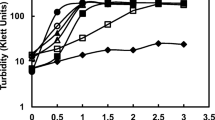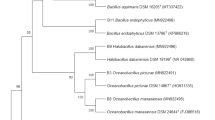Summary
The response of a salt-tolerantWestiellopsis prolifica ARM 366 and a sensitiveAnabaena C-10 to NaCl was studied. While the former could tolerate up to 400mm NaCl, the latter was highly sensitive to concentrations above 50mm NaCl. Under salt stress, the tolerantW. prolifica showed an increased nitrogen demand as exemplified by high nitrogenase activity, and growth inhibition at higher concentrations of NaCl did not appear to be a direct consequence of inhibition of nitrogen fixation. One of the striking responses to Na+ challenge by the tolerantW. prolifica was the excess production of extracellular polysaccharides which adsorbed the bulk of the Na+. The influx of Na+ into the cell was comparatively small.
Résumé
On a étudié la réponse au NaCl d'une souche halo-tolérante deWestiellopsis prolifica (ARM 366) et, d'une souche halo-sensible d'Anabaena (C-10). Alors que la première tolère jusqu'a 400mm NaCl, la seconde est hautement sensible aux concentrations supérieures à 50mm. Soumise à un choc de salinité, la souche halo-tolérante deW. prolifica présente une demande d'azote accrue, comme le montre une activité nitrogénase élevée, et l'inhibition de la croissance par une forte concentration en NaCl ne parait pas être la conséquence directe d'une inhibition de la fixation d'azote. Une réponse remarquable deW. prolifica à l'agression par Na+ est la production en excès de polysaccharides exo-cellulaires, qui absorbent la plus grande partie du Na+. La pénétration de Na+ dans la cellule est relativement faible.
Resumen
Se estudió la respuesta al NaCl deWestiellopsis prolifica ARM 366, organismo tolerante a la sal, y deAnabaena C-10 que es sensible. El primero pudo tolerar concentraciones de hasta 400mm NaCl, sin embargo Anabaena C-10 se mostró extremadament sensible a concentraciones superiores a 50mm de NaCl. Bajo condiciones de estrés salinoW. prolifica mostró un incremento en la demanda de N2, como se deduce de la elevada actividad nitrogenásica; la inhibición del crecimiento a concentraciones superiores de NaCl no se pudo relacionar directamente con la inhibición de la fijación de nitrógeno. Una de las respuestas más sorprendentes deW. prolifica frente al Na+ fue la producción de un exceso de polisaccaridos extracelulares que absorbieron gran parte del Na+. El flujo de Na+ hacia la célula fue, pues, comparativemente pequeño.
Similar content being viewed by others
References
Apte, S. K. &Thomas, J. 1983 Sodium transport in filamentous nitrogen fixing cyanobacteria.Journal of Bioscience 5, 225–234.
Apte, S. K. &Thomas, J. 1984 Effect of sodium on nitrogen fixation inAnabaena torulosa andPlectonema boryanum.Journal of General Microbiology 130, 1161–1168.
Barber, J. 1968 Measurement of the membrane potential and evidence for active transport of ions inChlorella pyrenoidosa.Biochimica et Biophysica Acta 150, 618–625.
Bennett, A. &Bogorad, L. 1973 Complementary chromatic adaptation in a filamentous blue-green algae.Journal of Cell Biology 58, 419–435.
Dewar, M. A. &Barber, J. 1973 Cation regulation inAnacystis nidulans.Planta 113, 143–155.
Epstein, E. 1980 Response of plants to saline environments. InGenetic Engineering of Osmoregulation, ed. Rains, D. W., Valentine, R. C. & Hollaender, A. pp. 7–21. New York: Plenum Press.
Flowers, T. J., Troke, P. K. &Yeo, A. R. 1977 The mechanism of salt tolerance in halophytes.Annual Review of Plant Physiology 28, 89–121.
Fogg, G. E. 1973 Physiology and ecology of marine blue-green algae. InThe Biology of Blue-green Algae, ed., Carr, N. G. & Whitton, B. A. pp. 368–378, Los Angeles: University of California Press.
Galinsky, E. A. &Trueper, H. G. 1982 Betaine, a compatible solute in the extremely halophilic phototrophic bacteriumEctothiorhodospira halochloris. FEMS Microbiology Letters 13, 357–360.
Kaushik, B. D. &Venkataraman, G. S. 1983 Reclamative capacity of blue-green algae in saline and sodic soils. InBiological Nitrogen Fixation, Proceedings of a National Symposium held at the Indian Agricultural Research Institute, New Delhi. pp. 377–388 Trombay, Bombay: Bhabha Atomic Research Centre.
Kaushik, B. D. &Venkataraman, G. S. 1983 Response of cyanobacterial nitrogen fixation to insecticides.Current Science 52, 321–323.
Lowry, O. H., Rosenbrough, N. J., Iarr, A. L. &Randall, R. J. 1951 Protein measurement with Folin phenol reagent.Journal of Biological Chemistry 193, 265–275.
Mackinney, G. 1941 Absorption of light by chlorophyll solutions.Journal of Biological Chemistry 140, 315–322.
Measures, J. C. 1975 Role of amino acids in osmoregulation of non-halophilic bacteria.Nature, London257, 398–400.
Mohammad, F. A. A., Reed, R. H. &Stewart, W. D. P. 1983 The halophilic cyanobacteriumSynechocystis DUN 52 and its osmotic responses.FEMS Microbiology Letters 16, 287–290.
Myers, J. &Kratz, W. A. 1956 Relations between pigment content and photosynthetic characteristics in blue-green algaJournal of General Physiology 39, 11–22.
Paschinger, H. 1977 DCCD induced sodium uptake byAnacystis nidulans.Archives of Microbiology 113, 285–291.
Reed, R. H. &Stewart, W. D. P. 1983 Physiological responses ofRivularia atra to salinity: osmotic adjustment in hyposaline media.New Phytologist 95, 595–603.
Richardson, D. C., Reed, R. H. &Stewart, W. D. P. 1983Synechocystis DCC 6803, a euryhaline cyanobacterium.FEMS Microbiology Letters 18, 99–102.
Roe, J. H. 1955 The determination of sugar in blood and spinal fluid with anthron reagent.Journal of Biological Chemistry 2112, 335–343.
Shkedy-Vinkler, C. &Avi-Dor, Y. 1975 Betaine induced stimulation of respiration at high osmolarities in a halotolerant bacterium.Biochemical Journal 150, 219–226.
Singh, R. N. 1950 Reclamation ofUsar lands in India through blue-green algae.Nature, London 165, 325–326.
Singh, R. N. 1961The Role of Blue-green Algae in Nitrogen Economy of Indian Agriculture. pp. 175. New Delhi: Indian Council of Agricultural Research.
Stanier, R. Y., Kunisawa, R., Mandal, M. &Cohen-Bazire, G. 1971 Purification and properties of unicellular blue-green algae (order Chroococcales).Bacteriological Reviews 35, 171–205.
Stewart, W. D. P. 1964 Nitrogen fixation by myxophyceae from marine environments.Journal of General Microbiology 36, 415–422.
Szalay, A. A. &Macdonald, R. E. 1980 Genetic engineering of halotolerance in microorganisms. InGenetic Engineering of Osmoregulation, ed. Rains, D. W., Valentine, R. C. & Hollaender, A. pp. 321–329. New York: Plenum Press.
Tel-orr, E. 1980 Response of N2-fixing cyanobacteria to salt.Applied and Environmental Microbiology 40, 689–693.
Thomas, J. 1978 Dinitrogen fixation by blue-green algae from paddy fields. In Proceedings of an Advisory Group Meeting,Isotopes of Biological Dinitrogen Fixation. pp. 89–103.Vienna: International Atomic Energy Agency.
Thomas, J. &Apte, S. K. 1984 Sodium requirements and metabolism in nitrogen fixing cyanobacteria.Journal of Bioscience 6, 771–794.
Van Baalen, C. 1962 Studies on marine blue-green algae.Botanica 4, 129–139.
Yopp, J. H., Miller, D. M. &Tindall, D. R. 1978 Regulation of intracellular water potential in the halophilic blue-green algaAphanothece halophytica (Chroococcales). InEnergetics and Structure of Halophilic Microorganisms, ed. Kaplan, S. R. & Ginzburg, M. pp. 619–624. Amsterdam: Elsevier Biomedical Press.
Author information
Authors and Affiliations
Rights and permissions
About this article
Cite this article
Jha, M.N., Venkataraman, G.S. & Kaushik, B.D. Response ofWestiellopsis prolifica andAnabaena sp. to salt stress. Mircen Journal 3, 307–317 (1987). https://doi.org/10.1007/BF00933584
Received:
Revised:
Accepted:
Issue Date:
DOI: https://doi.org/10.1007/BF00933584




